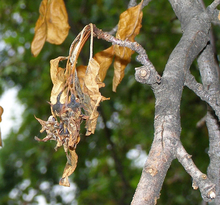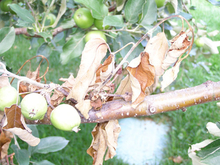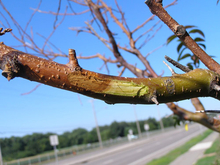Quick facts
- In Minnesota, fire blight is most often seen on apple, crabapple and mountain ash trees.
- Fire blight is a disease that can kill blossoms and shoots and cause dieback of branches from cankers.
- Severe fire blight can cause trees to die.
- Young leaves and shoots wilt and bend downward forming the shape of a hook.
- Trees with multiple infected shoots may appear scorched by fire.
- Prevent infections by planting resistant varieties.
- To manage fire blight, prune trees to remove infected branches before the disease kills the tree.
How to identify fire blight
Flower symptoms
- Flowers and flower clusters appear water-soaked, then droop and shrivel, turning brown or black.
- Brown to black flowers remain attached through the growing season.
- Flower infections in Minnesota are rare because of the cool temperatures when trees and shrubs are blooming.
Leaf symptoms
- Young leaves and shoots wilt and turn gray-green. These wilted shoots bend downward forming the characteristic hook.
- Leaves and infected shoots turn brown or black. Trees with multiple, infected shoots may appear scorched by fire.
- Brown leaves hang downward. Often, they cling to the blighted twig through the growing season and remain attached to the tree into winter.
Fruit symptoms
- Fruit turns dark and shrivels into a mummy. This shriveled fruit may cling to the branch for several months.
Bark symptoms
- Bark on branch or trunk cankers appear sunken, dark and may be cracked or peeling. If bark is peeled back, brown staining of the sapwood can be seen.
- Droplets of cream to light-yellow colored ooze is found along infected branches, shoots or fruit during humid weather or after a rain.
Environmental conditions
Fire blight causes the most damage when spring or summer weather is warm, humid or rainy. Temperatures between 75 and 82 F and humidity above 60 percent allow the bacteria to reproduce and spread.
Fire blight outbreaks often happen after events like hail, strong winds or heavy rain. These events can damage the tree and create wounds where the bacteria can enter.
Plants affected by fire blight
Fire blight is caused by the bacterium Erwinia amylovora. This disease affects over 130 plant species in the Rosaceae family worldwide.
In Minnesota, fire blight is most often seen on apple and crabapple (Malus spp.) and mountain ash (Sorbus spp.). The disease also can occur on raspberry (Rubus spp.), serviceberry (Amelanchier spp.), hawthorn (Crataegus spp.) and cotoneaster (Cotoneaster spp.).
How does fire blight survive and spread?
- The fire blight bacteria survive winter in cankers on the trunk or branches of infected trees.
- In spring, during warm, wet weather, bacteria begin to multiply. The bacteria seep out of the canker through natural openings or cracks as a sweet, sticky liquid known as bacterial ooze.
- Insects such as pollinators are attracted to this sweetness and carry the bacteria to wounds or flowers.
- Bacteria can also be moved by splashing water from rain or irrigation, or on the hands and tools of gardeners.
- The fire blight bacteria will live and multiply on the surface of leaves, twigs, flowers and immature fruit for a few weeks without causing symptoms.
- Bacteria need a wound or a natural opening to infect the tree.
- Many infections start when bacteria growing on flowers reach a certain population and enter the flower through natural openings.
- Young shoots are infected through small wounds caused by insect feeding, wind whipping of branches, blowing sand or other damage.
- Once the bacteria have infected either blossoms or shoots, the bacteria can move into the branch through the vascular system of the tree. New branch cankers are formed by bacteria moving into branches in this way.
- In highly susceptible cultivars, the bacteria can move into the main trunk of the tree and even the roots. At this point, the tree will die.
How to manage fire blight
Plant resistant tree varieties
There are no known trees or shrubs in the Rosaceae family that are completely immune to fire blight. Some varieties can defend themselves by limiting or slowing the spread of the disease. This gives the gardener time to prune out the infected branches before the infection reaches the main trunk of the tree.
Varieties are often ranked by their ability to resist infection and slow the progression of disease. Since new varieties are brought to market each year, check with a reputable nursery about the disease resistance characteristics of new cultivars.
Edible apple and crabapple (Malus spp.)
Most resistant
- Haralson
- Liberty
- Red Baron
- SnowSweet
- Chestnut crab
- Dolgo crab
Less resistant
- Cortland
- Keepsake
- McIntosh
- State Fair
- Sweet Sixteen
- Centennial crab
- Whitney crab
Somewhat resistant
- HoneycrispTM
- Zestar!TM
Least resistant
- Beacon
- Fireside
- Honeygold
- Paulared
- Wealthy
Ornamental crabapple (Malus spp.)
Most resistant
- Adams
- Adirondack
- Camelot
- Lancelot
- Tina
- Dolgo
- David
Less resistant
- Golden Raindrops
- Purple Prince
- Red Jade
- Spring Snow
- SugarTyme
Somewhat resistant
- Candymint
- Pink Princess
- Red Splendor
- Silverdrift
Least resistant
- Madonna
- Sinai Fire
- Snowdrift
Cotoneaster (Cotoneaster)
- Creeping cotoneaster (C. adpressus) has moderate resistance to fire blight.
Hawthorn (Crataegus)
- One European study tested 84 species of Crataegus for resistance to fire blight. Most were moderately susceptible.
- Downy Hawthorn (C. mollis) was one of the most resistant species tested.
Mountain ash (Sorbus)
- European mountain ash (S. aucuparia) was moderately resistant in some studies but very susceptible in others. This may be due to genetic variation within the species. More research is needed to learn about the resistance of this species to fire blight.
Twigs and branches infected with fire blight can be pruned out in order to prevent the infection from spreading to the main trunk.
- Prune diseased twigs and branches in late winter when the tree and bacteria are dormant. This reduces the amount of sucker growth from wounds and eliminates the chance of spreading infections between pruning cuts.
- Make the pruning cut through healthy wood at least 8 inches below the discolored bark of a canker.
- If fire blight is seriously damaging a cotoneaster hedge, cut the hedge to about six inches above the ground in late winter. If only a few stems are blighted, they can be removed as described above.
- If pruning must be done during the growing season, sterilize pruning tools between each cut. To sterilize, spray the cutting blade with disinfectant or soak the cutting surface in disinfectant for at least 1 minute. Effective disinfectants include a 10% bleach solution and undiluted Lysol®.
- A 10% bleach solution can be made by mixing one part household bleach to nine parts water. This equals 1.5 cups of bleach to 1 gallon of water.
- Burn or bury infected cuttings.
- If the infection reaches the main trunk, the disease cannot be cured and the tree will eventually die. If this happens, it’s best to remove the entire tree along with the stump. This will eliminate one source of bacteria for the rest of the susceptible plants in the area.
These practices stimulate excessive succulent growth of leaves and shoots. New growth is very susceptible to fire blight infection. For best fertilization rates, submit a soil sample to the soil testing laboratory and follow the recommendations.
Healthy trees should be pruned to maintain an open canopy. This allows air to dry all the leaves quickly after rain or dew. This is important since bacteria thrive and multiply best in warm, humid environments. For proper pruning of apples see Growing apples in the home garden.
Pesticides are usually not necessary to control fire blight in Minnesota. They should be used only if fire blight continues to be a yearly problem in your yard.
- If blossom blight and early season shoot blight have been a recurring problem, products with the active ingredients listed below can be used to protect blossoms.
- If fire blight has been a problem in the area and a hail storm occurs, the pesticides listed below will help protect the trees from wound infections but only if the product is applied immediately after the storm.
- Pesticides are completely ineffective against branch cankers.
Pesticides for controlling fire blight
- Copper-based pesticide
- Streptomycin sulfate
- Serenade Garden Defense (Bacillus subtillis)
See Managing diseases and insects in home apple trees for specific information on controlling fire blight in home apple trees.
CAUTION: Mention of a pesticide or use of a pesticide label is for educational purposes only. Always follow the pesticide label directions attached to the pesticide container you are using. Be sure that the area you wish to treat is listed on the label of the pesticide you intend to use. Remember, the label is the law.
Reviewed in 2024






